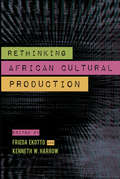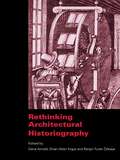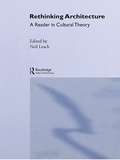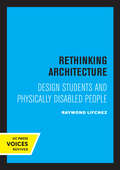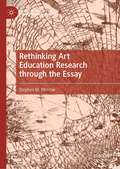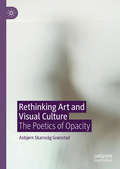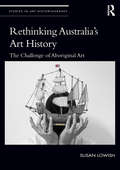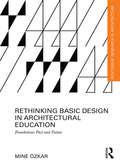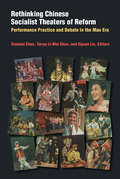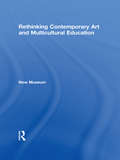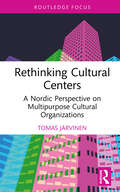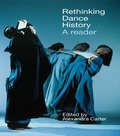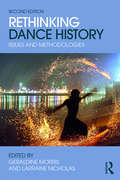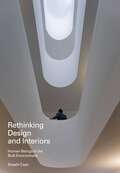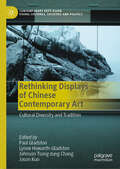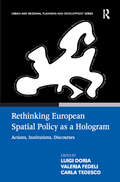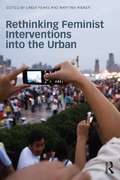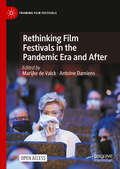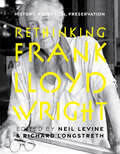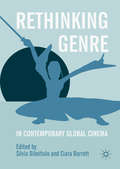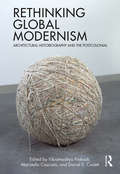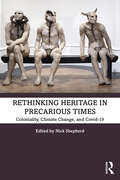- Table View
- List View
Rethinking Aesthetics: The Role of Body in Design
by Ritu BhattRethinking Aesthetics is the first book to bring together prominent voices in the fields of architecture, philosophy, aesthetics, and cognitive sciences to radically rethink the relationship between body and design. These essays argue that aesthetic experiences can be nurtured at any moment in everyday life, thanks to recent discoveries by researchers in neuroscience, phenomenology, somatics, and analytic philosophy of the mind, who have made the correlations between aesthetic cognition, the human body, and everyday life much clearer. The essays, by Yuriko Saito, Juhani Pallasmaa, and Richard Shusterman, among others, range from an integrated mind-body approach to chair design, to Zen Buddhist notions of mindfulness, to theoretical accounts of existential relationships with buildings, to present a full spectrum of possible inquiries. By placing the body in the center of design, Rethinking Aesthetics opens new directions for rethinking the limits of both essentialism and skepticism.
Rethinking Aesthetics: The Role of Body in Design
by Ritu BhattRethinking Aesthetics is the first book to bring together prominent voices in the fields of architecture, philosophy, aesthetics, and cognitive sciences to radically rethink the relationship between body and design. These essays argue that aesthetic experiences can be nurtured at any moment in everyday life, thanks to recent discoveries by researchers in neuroscience, phenomenology, somatics, and analytic philosophy of the mind, who have made the correlations between aesthetic cognition, the human body, and everyday life much clearer. The essays, by Yuriko Saito, Juhani Pallasmaa, and Richard Shusterman, among others, range from an integrated mind-body approach to chair design, to Zen Buddhist notions of mindfulness, to theoretical accounts of existential relationships with buildings, to present a full spectrum of possible inquiries. By placing the body in the center of design, Rethinking Aesthetics opens new directions for rethinking the limits of both essentialism and skepticism.
Rethinking African Cultural Production
by Kenneth W. Harrow Frieda EkottoFrieda Ekotto, Kenneth W. Harrow, and an international group of scholars set forth new understandings of the conditions of contemporary African cultural production in this forward-looking volume. Arguing that it is impossible to understand African cultural productions without knowledge of the structures of production, distribution, and reception that surround them, the essays grapple with the shifting notion of what "African" means when many African authors and filmmakers no longer live or work in Africa. While the arts continue to flourish in Africa, addressing questions about marginalization, what is center and what periphery, what traditional or conservative, and what progressive or modern requires an expansive view of creative production.
Rethinking Architectural Historiography
by Dana Arnold Elvan Altan Ergut Belgin Turan ÖzkayaRather than subscribing to a single position, this collection informs the reader about the current state of the discipline looking at changes across the broad field of methodological, theoretical and geographical plurality. Divided into three sections, Rethinking Architectural Historiography begins by renegotiating foundational and contemporary boundaries of architectural history in relation to other fields, such as art history and archaeology. It then goes on to critically engage with past and present histories, disclosing assumptions, biases and absences in architectural historiography. It concludes by exploring the possibilities provided by new perspectives, reframing the discipline in the light of new parameters and problematics. This timely and illustrated title reflects upon the current changes in historiographical practice, exploring potential openings that may contribute further transformation of the disciplines and theories on architectural historiography and addresses the current question of the disciplinary particularity of architectural history.
Rethinking Architecture: A Reader in Cultural Theory
by Neil LeachBrought together for the first time - the seminal writing on architecture by key philosophers and cultural theorist of the twentieth century.Issues around the built environment are increasingly central to the study of the social sciences and humanities. The essays offer a refreshing take on the question of architecture and provocatively rethink many of the accepted tenets of architecture theory from a broader cultural perspective.The book represents a careful selection of the very best theoretical writings on the ideas which have shaped our cities and our experiences of architecture. As such, Rethinking Architecture provides invaluable core source material for students on a range of courses.
Rethinking Architecture: Design Students and Physically Disabled People
by Raymond LifchezThis title is part of UC Press's Voices Revived program, which commemorates University of California Press’s mission to seek out and cultivate the brightest minds and give them voice, reach, and impact. Drawing on a backlist dating to 1893, Voices Revived makes high-quality, peer-reviewed scholarship accessible once again using print-on-demand technology. This title was originally published in 1987.
Rethinking Art Education Research through the Essay (Palgrave Studies in Educational Futures)
by Stephen M. MorrowThis book explores the pedagogical applications of critical thinking in art education and scholarship. In the first part of the book, the author delves into the ways that arts-based educational research has incorporated critical thinking in order to illuminate the context for the subsequent study. The second half of the book focuses on the essay as a genre used in creative nonfiction and film in order to enact the concept of critical thinking in art education. In this way, the book sheds light on a new landscape of thinking arts education and thinking scholarship through the essay that is practiced in creative nonfiction and cinema.
Rethinking Art and Visual Culture: The Poetics of Opacity
by Asbjørn Skarsvåg GrønstadThis is the first book to offer a systematic account of the concept of opacity in the aesthetic field. Engaging with works by Ernie Gehr, John Akomfrah, Matt Saunders, David Lynch, Trevor Paglen, Zach Blas, and Low, the study considers the cultural, epistemological, and ethical values of images and sounds that are fuzzy, indeterminate, distorted, degraded, or otherwise indistinct. Rethinking Art and Visual Culture shows how opaque forms of art address problems of mediation, knowledge, and information. It also intervenes in current debates about new systems of visibility and surveillance by explaining how indefinite art provides a critique of the positivist drive behind these regimes. A timely contribution to media theory, cinema studies, American studies, and aesthetics, the book presents a novel and extensive analysis of the politics of transparency.
Rethinking Australia’s Art History: The Challenge of Aboriginal Art (Studies in Art Historiography)
by Susan LowishThis book aims to redefine Australia’s earliest art history by chronicling for the first time the birth of the category "Aboriginal art," tracing the term’s use through published literature in the late eighteenth, nineteenth and early twentieth centuries. Susan Lowish reveals how the idea of "Aboriginal art" developed in the European imagination, manifested in early literature, and became a distinct classification with its own criteria and form. Part of the larger story of Aboriginal/European engagement, this book provides a new vision for an Australian art history reconciled with its colonial origins and in recognition of what came before the contemporary phenomena of Aboriginal art.
Rethinking Basic Design in Architectural Education: Foundations Past and Future (Routledge Research in Architecture)
by Mine OzkarRethinking Basic Design in Architectural Education provides historical and computational insights into beginning design education for architecture. Inviting the readers to briefly forget what is commonly known as basic design, it delivers the account of two educators, Denman W. Ross and Arthur W. Dow, from the turn of the twentieth century in Northeast America, interpreting key aspects of their methodology for teaching foundations for design and art. This alternate intellectual context for the origins of basic design as a precursor to computational design complements the more haptic, more customized, and more open-source design and fabrication technologies today. Basic design described and illustrated here as a form of low-tech computation offers a setting for the beginning designer to consciously experience what it means to design. Individualized dealings with materials, tools, and analytical techniques foster skills and attitudes relevant to creative and technologically adept designers. The book is a timely contribution to the theory and methods of beginning design education when fast-changing design and production technology demands change in architecture schools’ foundations curricula.
Rethinking Chinese Socialist Theaters of Reform: Performance Practice and Debate in the Mao Era
The profound political, economic, and social changes in China in the second half of the twentieth century have produced a wealth of scholarship; less studied however is how cultural events, and theater reforms in particular, contributed to the dynamic landscape of contemporary Chinese society. Rethinking Chinese Socialist Theaters of Reform fills this gap by investigating the theories and practice of socialist theater and their effects on a diverse range of genres, including Western-style spoken drama, Chinese folk opera, dance drama, Shanghai opera, Beijing opera, and rural theater. Focusing on the 1950s and ’60s, when theater art occupied a prominent political and cultural role in Maoist China, this book examines the efforts to remake theater in a socialist image. It explores the unique dynamics between official discourse, local politics, performance practice, and audience reception that emerged under the pressures of highly politicized cultural reform as well as the off-stage, lived impact of rapid policy change on individuals and troupes obscured by the public record. This multidisciplinary collection by leading scholars covers a wide range of perspectives, geographical locations, specific research methods, genres of performance, and individual knowledge and experience. The richly diverse approach leads readers through a nuanced and complex cultural landscape as it contributes significantly to our understanding of a crucial period in the development of modern Chinese theater and performance.
Rethinking Contemporary Art and Multicultural Education
by New MuseumFor over a decade, Contemporary Art and Multicultural Education has served as the guide to multicultural art education, connecting everyday experience, social critique, and creative expression with classroom learning. The much-anticipated Rethinking Contemporary Art and Multicultural Education continues to provide an accessible and practical tool for teachers, while offering new art, essays, and content to account for transitions and changes in both the fields of art and education. A beautifully-illustrated collaboration of over one hundred artists, writers, curators, and educators from in and around the contemporary art world, this volume offers thoughtful and innovative materials that challenge the normative practices of arts education and traditional art history. Rethinking Contemporary Art and Multicultural Education builds upon the pedagogy of the original to present new possibilities and modes of understanding art, culture, and their relationships to students and ourselves. The fully revised second edition provides new theoretical and practical resources for educators and students everywhere, including: Educators' perspectives on contemporary art, multicultural education, and teaching in today’s classroom Full-color reproductions and writings on over 50 contemporary artists and their works, plus an additional 150 black-and-white images throughout Lesson plans for using art to explore topical issues such as activism and democracy, conflict: local and global, and history and historicism A companion website offering over 250 color reproductions of artwork from the book, a glossary of terms, and links to the New Museum and G: Class websites---www.routledge.com/textbooks/9780415960854.
Rethinking Cultural Centers: A Nordic Perspective on Multipurpose Cultural Organizations (Routledge Focus on the Global Creative Economy)
by Tomas JärvinenWhat are cultural centers for? This book offers a unique and dynamic guide to managing these organizations, and the challenge of reconciling cultural aims with business success. Drawing on research and practice, it provides case- based insights into common managerial problems and their solutions. Although international research demonstrates that culture has positive economic impact and many cultural institutions are multimillion dollar institutions, there has been little research on how cultural centers are managed to combine cultural and economic impact. Due to the diversity of their missions and purpose, cultural centers in Europe often struggle to find business success. By drawing on recent cases from Finland and Sweden, and focusing on the challenges that face both managers and organizations, this book explores the incentives that underpin the foundation of cultural centers, and what is needed to make them a success. By defining the complex challenges that face cultural centers, this book enables managers to move beyond administrating an organization to becoming cultural entrepreneurs, turning good ideas into good business. In this underresearched area, this book will be essential reading for researchers, policy makers and managers working in cultural centers and museum management.
Rethinking Dance History: A Reader
by Geraldine Morris Larraine NicholasBy taking a fresh approach to the study of history in general, Alexandra Carter's Rethinking Dance History offers new perspectives on important periods in dance history and seeks to address some of the gaps and silences left within that history. Encompassing ballet, South Asian, modern dance forms and much more, this book provides exciting new research on topics as diverse as: *the Victorian music hall *film musicals and popular music videos *the impact of Neoclassical fashion on ballet *women's influence on early modern dance *methods of dance reconstruction. Featuring work by some of the major voices in dance writing and discourse, this unique anthology will prove invaluable for both scholars and practitioners, and a source of interest for anyone who is fascinated by dance's rich and multi-layered history.
Rethinking Dance History: Issues and Methodologies
by Geraldine Morris Larraine NicholasThe need to ‘rethink’ and question the nature of dance history has not diminished since the first edition of Rethinking Dance History. This revised second edition addresses the needs of an ever-evolving field, with new contributions considering the role of digital media in dance practice; the expansion of performance philosophy; and the increasing importance of practice-as-research. A two-part structure divides the book’s contributions into: • Why Dance History? – the ideas, issues and key conversations that underpin any study of the history of theatrical dance. • Researching and Writing – discussions of the methodologies and approaches behind any successful research in this area. Everyone involved with dance creates and carries with them a history, and this volume explores the ways in which these histories might be used in performance-making – from memories which establish identity to re-invention or preservation through shared and personal heritages. Considering the potential significance of studying dance history for scholars, philosophers, choreographers, dancers and students alike, Rethinking Dance History is an essential starting point for anyone intrigued by the rich history and many directions of dance.
Rethinking Design and Interiors: Human Beings In The Built Environment
by Shashi CaanThe world and the people living in it are increasingly and rapidly being affected by environmental and technological changes. It is imperative that the design profession addresses these developments with a new way of thinking. This book points the way for the design of interiors in this newly complex world and will be indispensable for students, practitioners and theoreticians.The book is divided into four chapters that explore aspects of the human experience of the interior, from man’s earliest search for shelter to an outline of past and current thinking on design, psychology and well-being. An epilogue looks at such future concerns as population growth and sustainability and suggests how the design profession can confront these challenges.Rethinking Design and Interiors is a fascinating exploration of how art and science can come together for the benefit of those who inhabit the built environment.
Rethinking Design and Interiors: Human Beings in the Built Environment
by Shashi CaanThe world and the people living in it are increasingly and rapidly being affected by environmental and technological changes. It is imperative that the design profession addresses these developments with a new way of thinking. This book points the way for the design of interiors in this newly complex world and will be indispensable for students, practitioners and theoreticians.The book is divided into four chapters that explore aspects of the human experience of the interior, from man’s earliest search for shelter to an outline of past and current thinking on design, psychology and well-being. An epilogue looks at such future concerns as population growth and sustainability and suggests how the design profession can confront these challenges.Rethinking Design and Interiors is a fascinating exploration of how art and science can come together for the benefit of those who inhabit the built environment.
Rethinking Displays of Chinese Contemporary Art: Cultural Diversity and Tradition (Contemporary East Asian Visual Cultures, Societies and Politics)
by Paul Gladston Lynne Howarth-Gladston Johnson Tsong-zung Chang Jason KuoThis is the first edited collection to critically address in its entirety questions related to the displaying of Chinese contemporary art. It includes chapters by scholars and cultural workers from diverse backgrounds involved in the interpretation of artistic as well as curatorial discourses and practices. Each of those chapters gives a detailed account of a particular, socio-culturally informed, approach to the making and showing of Chinese art - including in relation to queer identities, transculturality, the use of social media, artivism, social engagement, institutional critique, and neo-Confucian aesthetics. Together they present a vital intervention with established curatorship amidst the intensely interconnected and increasingly multi-polar cultural conditionalities of early 21st-century contemporaneity.
Rethinking European Spatial Policy as a Hologram: Actions, Institutions, Discourses (Urban and Regional Planning and Development Series)
by Valeria FedeliBringing together case studies from several European countries, this book provides an in-depth examination of the evolution of European spatial policy. Contributors focus on changes to the design and implementation of European policies at both national and local levels and examine institutional change, particularly Europeanization, European governance and EU enlargement. Rhetorical, discursive and representational dimensions are also interlinked to explore synergies and conflicts. The volume offers an experimentation of new interpretative approaches to spatial planning which will prove essential to the international debate.
Rethinking Feminist Interventions into the Urban
by Linda Peake Martina RiekerIn Rethinking Feminist Interventions into the Urban, Linda Peake and Martina Rieker embark on an ambitious project to explore the extent to which a feminist re-imagining of the twenty-first century city can form the core of a new emerging analytic of women and the neoliberal urban. In a world in which the majority of the population now live in urban centres, they take as their starting point the need to examine the production of knowledge about the city through the problematic divide of the global north and south, asking what might a feminist intervention, a position itself fraught with possibilities and problems, into this dominant geographical imaginary look like. Providing a meaningful discussion of the ways in which feminism, gender and women have been understood in relation to the city and urban studies, they ask probing and insightful questions that indicate new directions for theory and research, illustrating the necessity of a re-formulation of the north-south divide as a critical and urgent project for feminist urban studies. Working through platforms as diverse as policy formulations and telling stories, the contributors to the book come from a range of disciplinary backgrounds and geographic locations ranging through the Caribbean, North America, Western Europe, South, East and South East Asia, the Middle East and Latin America. They identify a range of issues (such as care, work, violence, the household, mobility, intimacy and poverty) that they analytically address to make sense of and reanimate resistance to the contemporary urban through articulations of new grammars of gendered geographies of justice.
Rethinking Film Festivals in the Pandemic Era and After (Framing Film Festivals)
by Marijke De Valck Antoine DamiensThis is an open access book. This edited collection aims to document the effects of Covid-19 on film festivals and to theorize film festivals in the age of social distancing. To some extent, this crisis begs us to consider what happens when festivals can’t happen; while films have found new (temporary) channels of distribution (most often in the forms of digital releases), the festival format appears particularly vulnerable in pandemic times. Imperfect measures, such as the move to a digital format, cannot recapture the communal experience at the very core of festivals. Given the global nature of the pandemic and the diversity of the festival phenomenon, this book features a wide range of case studies and analytical frameworks. With contributors including established scholars and frontline festival workers, the book is conceived as both a theoretical endeavour and a practical exploration of festival organizing in pandemic times.
Rethinking Frank Lloyd Wright: History, Reception, Preservation
by Neil Levine Richard LongstrethAmong the general public, Frank Lloyd Wright remains the best-known American architect of the twentieth century. And yet his larger-than-life profile in the popular realm contrasts sharply with his near invisibility in academic and professional circles. In Rethinking Frank Lloyd Wright, Neil Levine and Richard Longstreth have assembled a group of eminent scholars to address this most puzzling paradox of the great architect’s career.In a series of engaging and well-illustrated essays, the contributors draw on their wide-ranging understanding of modern architecture to reveal the ways in which Wright continues to play an instrumental role in domestic and international spheres, making the case for reevaluating his popular and professional reputations. Prompted by the transfer of the architect’s archive from its home at Taliesin West in Scottsdale, Arizona, to the Avery Library at Columbia University and the Museum of Modern Art, this volume revisits Wright’s relevance for a contemporary audience.ContributorsBarry Bergdoll, Columbia University · Daniel Bluestone, Boston University · Jean-Louis Cohen, New York University · Cammie McAtee, independent scholar · Neil Levine, Harvard University · Dietrich Neumann, Brown University · Timothy M. Rohan, University of Massachusetts Amherst · Richard Longstreth, George Washington University · Jack Quinan, University at Buffalo · Alice Thomine-Berrada, École des Beaux-Arts
Rethinking Genre in Contemporary Global Cinema
by Silvia Dibeltulo Ciara BarrettRethinking Genre in Contemporary Global Cinema offers a unique, wide-ranging exploration of the intersection between traditional modes of film production and new, transitional/transnational approaches to film genre and related discourses in a contemporary, global context. This volume’s content—the films, genres, and movements explored, as well as methodologies used in their analysis—is diverse and, crucially, up-to-date with contemporary film-making practice and theory. Significantly, the collection extends existing scholarly discourse on film genre beyond its historical bias towards a predominant focus on Hollywood cinema, on the one hand, and a tendency to treat “other” national cinemas in isolation and/or as distinct systems of production, on the other. In view of the ever-increasing globalisation and transnational mediation of film texts and screen media and culture worldwide, the book recognises the need for film genre studies and film genre criticism to cast a broader, indeed global, scope. The collection thus rethinks genre cinema as a transitional, cross-cultural, and increasingly transnational, global paradigm of film-making in diverse contexts.
Rethinking Global Modernism: Architectural Historiography and the Postcolonial
by Vikramaditya Prakash Daniel E. Coslett Maristella CasciatoThis anthology collects developing scholarship that outlines a new decentred history of global modernism in architecture using postcolonial and other related theoretical frameworks. By both revisiting the canons of modernism and seeking to decolonize and globalize those canons, the volume explores what a genuinely "global" history of architectural modernism might begin to look like. Its chapters explore the historiography and weaknesses of modernism's normative interpretations and propose alternatives to them. The collection offers essays that interrogate transnationalism in new ways, reconsiders the agency of the subaltern and the roles played by infrastructures, materials, and global institutions in propagating a diversity of modernisms internationally. Issues such as colonial modernism, architectural pedagogy, cultural imperialism, and spirituality are engaged. With essays from both established scholars and up-and-coming researchers, this is an important reference for a new understanding of this crucial and developing topic.
Rethinking Heritage in Precarious Times: Coloniality, Climate Change, and Covid-19
by Nick ShepherdRethinking Heritage in Precarious Times sets a fresh agenda for Heritage Studies by reflecting upon the unprecedented nature of the contemporary moment. In doing so, the volume also calls into question established ideas, ways of working, and understandings of the future. Presenting contributions by leading figures in the field of Heritage Studies, Indigenous scholars, and scholars from across the global north and global south, the volume engages with the most pressing issues of today: coloniality, the climate emergency, the Covid-19 pandemic, structural racism, growing social and economic inequality, and the ongoing struggle for dignity and restitution.Considering the impact of climate change, chapters re-imagine museums for climate action, explore the notion of a world heritage for the Anthropocene, and reflect on heritage and posthumanism. Drawing inspiration from the global demonstrations against racism, police violence and authoritarianism, chapters explore the notion of a people’s heritage, draw on local and Indigenous conceptualizations to lay out a notion of heritage in the service of social justice and restitution, and detail the precariousness of universities and heritage institutions in the global south. Analysing the ongoing impact of the Covid-19 pandemic, chapters also explore the changing nature of life under lockdown, describe its effects on theories of urbanity, and reflect on emergent Covidsocialities and heritage-in-the-making. Rethinking Heritage in Precarious Times argues that we need the deep-time perspective that Heritage Studies offers, as well as its sense of transgenerational conversations andaccountabilities, in order to respond to these many challenges—and to craft open,creative, and inclusive futures. It will be essential reading for academics and studentsengaged in the study of heritage, anthropology, memory, history, and geography.

